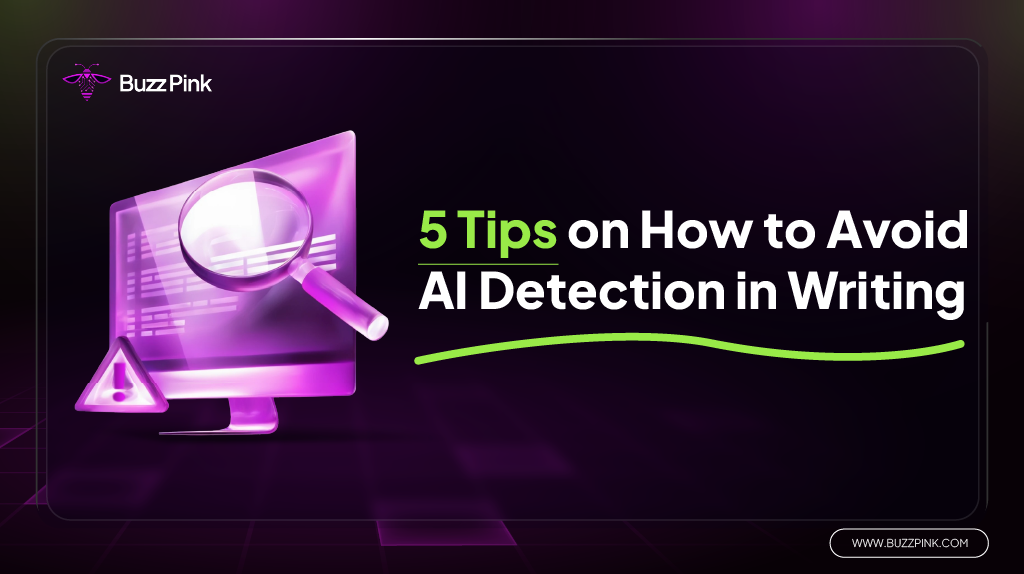Nowadays, it’s easier to just use AI for everyday activities, including writing. As easy as it may sound, the outcome doesn’t always satisfy what you hoped for. Stiff and repetitive paragraphs may show up. It leaves you wondering how to avoid AI detection in writing.
Before you panic, remember that AI is just a tool, and with the right approach, you can still make its output sound natural and human-like. Worry not, there are ways to avoid AI detection in writing by implementing the most effective ways we’ve come up with. By reading this article, all your worries about getting detected using AI will vanish. Grab a cup of tea, and happy reading!
Why It Matters to Avoid Fully Using AI for Writing
 Relying solely on AI for writing may appear to be a pipe dream, with speed, ease, and the ability to deliver content in seconds. However, when everything you produce comes directly from AI, your writing loses its soul. It may appear neat and organized, but it frequently lacks the personal touch that connects with readers. People can tell when a piece of writing is too stiff or overly perfect, which can turn them off.
Relying solely on AI for writing may appear to be a pipe dream, with speed, ease, and the ability to deliver content in seconds. However, when everything you produce comes directly from AI, your writing loses its soul. It may appear neat and organized, but it frequently lacks the personal touch that connects with readers. People can tell when a piece of writing is too stiff or overly perfect, which can turn them off.
Another big concern is accuracy. AI tools sometimes produce what’s known as “hallucinations,” where they generate information that sounds right but is actually wrong. If you just copy and paste what AI gives you without fact-checking, you risk spreading misinformation. This can hurt your credibility, especially if your audience relies on you for accurate knowledge or professional advice.
There’s also the problem of originality. AI-generated writing tends to follow predictable patterns and phrases, which means multiple people could end up with very similar content. This makes your work less unique and could even hurt your SEO performance if search engines detect duplicate or low-value content. Original, human-written insights are still valued more highly than text that feels mass-produced.
Finally, writing is about expressing your personality, perspective, and ideas. When you fully rely on AI, you’re letting a machine speak for you, so your authentic voice gets lost. Finding a balance between using AI as a helpful assistant and maintaining your own style is key to creating content that resonates with readers and stands out from the crowd.
5 Tips on How to Avoid AI Detection in Writing
 Writing in the age of AI can be both exciting and challenging. On one hand, AI tools can help you write faster, brainstorm ideas, and even polish your sentences. On the other hand, overusing them can make your work sound too robotic, and worse, get flagged by AI detection tools. This is why knowing how to make your writing sound more natural is no longer just an option but a necessity.
Writing in the age of AI can be both exciting and challenging. On one hand, AI tools can help you write faster, brainstorm ideas, and even polish your sentences. On the other hand, overusing them can make your work sound too robotic, and worse, get flagged by AI detection tools. This is why knowing how to make your writing sound more natural is no longer just an option but a necessity.
AI detection tools are getting smarter every day, which means simply rephrasing a few sentences won’t cut it anymore. If you want your content to sound original and truly human, you need a strategy. The good news? It’s not as hard as it sounds. By applying the right techniques and using AI tools the right way, you can keep your writing authentic and engaging while still taking advantage of technology’s benefits.
1. Do Not Copy and Paste Right Away
“Why should I bother to write when I can just copy and paste right away?” That is partially true. We say partially because why bother with the hassle of writing from scratch, but also, at the same time, it possesses no originality.
Copying and pasting sounds too good to be true in terms of writing patterns, and not to mention data validity. Although some AI gen tools can pull real-time data, the validity of them remains unsure. There is a possibility of the AIs to blunder, or what we usually call hallucinations. As mentioned earlier, hallucinations in AI refer to when the tool generates false information.
Therefore, it is crucial to note that you can’t just copy and paste right away. A writing with no sense of originality is still a writing, by the way, but it most likely will bore the readers.
Imagine reading a paper that is repetitive and feels robotic. Trust us, in less than 5 minutes, you’d notice the pattern and would immediately close the writing page. Moreover, the nonsense keyword stuffing would make it more visible that the writing isn’t originally written by humans.
Taking the time to rewrite, refine, or even add your own perspective can make a huge difference. Not only does it make your content more unique, but it also helps build trust with your readers. People are more likely to engage with content that feels intentional and authentic rather than copied and pasted straight from somewhere else.
2. Use AI for Brainstorming Only
Following the first point earlier, you can utilize AI for brainstorming instead. This way, you can still work fast without erasing the originality of your writing. Plus point, you get a responsive friend who can enlighten you to some new ideas.
Ideas over ideas, there are endless possibilities, and the AI will never grow tired of you. You can ask them to assist you in creating a mind map or an outline for a writing. This way, not only can you be enlightened, but also you can write faster, as the tool has already organized it for you.
Remember, you don’t always have to start from scratch. It’s totally okay to ask for help from AI gen tools. However, it’s worth noting that it shouldn’t define your whole writing. At the end of the day, your writing has to have a strong personality, and that’s what AI is here for: your brainstorming friend to the rescue.
The key is to strike a balance between using AI to jumpstart your creative process and ensuring your voice shines through. Treat the AI like a supportive collaborator, not the main author of your work. That way, your writing will remain original while still benefiting from the efficiency AI brings.
3. Imply Prompt Engine to Help Your Writing
We won’t go over what “prompt engineer” and “prompt engineering” are in detail because we’ve written an article about it specifically, which you can find below. However, for a brief description, using the prompt engine makes the entire brainstorming process easier.
Read More: What Is Prompt Engineering? A Beginner’s Guide to Mastering AI Communication
Implementing the prompt engine in the writing process could speed things up even more. There are several types of prompt engine templates that you can use when working with AI.
For example, the few-shot learning technique. It is a technique that involves giving the AI a few examples before asking it to complete a similar task. This is particularly useful if you want the AI to follow a specific format or style.
Example prompt: “Here’s an example of a poem by novelist Maya Angelou. Now, write me a poem on a similar subject and in a similar style.” By providing examples, the AI will better understand the context and style you desire, resulting in more accurate results and meeting expectations.
Experimenting with different prompts will also help you get better results over time. The more specific and creative you are with your prompts, the more unique and helpful the output becomes. Treat it like training the AI to think the way you want, so it becomes more of a writing assistant tailored to your style.
After the AI has provided you with the result, you can modify it or even follow the style and write your own. This way, you will undoubtedly avoid AI detection in writing.
4. Use Paraphrasing Tools If You’re Stuck
Sometimes, despite already doing all of these effective tips, you’re still stuck and get detected as an AI. Relax, it is completely normal for humans to experience writer’s block, especially if you have expanded your vocabulary while still being considered your writing is AI-based.
Using a paraphrasing tool may save your day. Tools like Grammarly and Quillbot are extremely useful in a crisis time like this, and there’s no shame in using them. After all, they’re just tools for smoothing out your writing while keeping your original content intact.
Read More: What Is Paraphrasing and How to Do It: A Step by Step Guide
However, it is critical to always double-check the paraphrased sentences before using them. They can sometimes shorten your sentence to the point where the original meaning is lost. Alternatively, they can be excessively long, giving your writing the appearance of rambling.
Another tip is to use paraphrasing tools as a way to inspire new sentence structures rather than just hitting “rewrite” and copying the result. When you see the new version, tweak it, merge it with your own words, and adjust the tone. This extra effort will make the final output sound more like you.
5. Use Humanizer Tools for Your Last Resort
As the heading says, this will be your last resort. Why do we say it should be the last resort? Because, despite its fast and guaranteed human-like writing, it comes with a price.
For example, Surfer SEO. Not to offend or anything, but it’s not budget-friendly. However, of course, it comes with its great features that can actually and literally save your writing to be more humanized. Not only that, but it can also ensure that your writing is original, meaning no plagiarism.
Humanizer tools can be a lifesaver when deadlines are tight, but they should not replace your own creativity. Over-relying on them can make your content feel too generic, even if it passes AI detection. Always make sure you read through the final output and sprinkle in your own touch before publishing.
Conclusion
Avoiding AI detection isn’t about rejecting technology, but it’s about using it wisely. With the right balance, you can combine AI’s speed with the originality and emotional connection of human writing. By following these tips, from skipping copy-paste habits to using AI for brainstorming, experimenting with prompts, paraphrasing carefully, and saving humanizer tools as a last resort, your content will stay natural and engaging.
At the end of the day, your writing should reflect your unique voice. AI can help you start, but it shouldn’t replace your creativity. Take time to refine and personalize your work before publishing to build trust with readers and stand out from generic, machine-like content.
Kamila Putri is a content strategist and digital marketing expert who helps brands craft messages that resonate and drive results. With a strong foundation in SEO, brand voice, and data-driven strategy, she has produced content that performs, whether it's optimized web copy, lead-generating campaigns, or conversion-focused messaging. At Buzz Pink, she applies this expertise to help clients grow through smart, search-focused digital strategies that engage, inform, and convert.


